This set of Basic Electrical Engineering Multiple Choice Questions & Answers (MCQs) focuses on “Series Circuits and Parallel Networks”.
1. It is preferable to connect bulbs in series or in parallel?
a) Series
b) Parallel
c) Both series and parallel
d) Neither series nor parallel
View Answer
Explanation: Bulbs are connected in parallel so that even if one of the bulbs blow out, the others continue to get a current supply.
2. Calculate the total resistance between the points A and B.
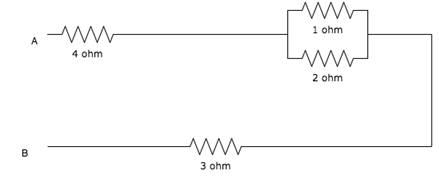
a) 7 ohm
b) 0 ohm
c) 7.67 ohm
d) 0.48 ohm
View Answer
Explanation: 1 ohm in parallel with 2 ohm give 2/3 ohm equivalent which is in series with 4 ohm and 3 ohm so total resistance between A and B = 4 + 2/3 + 3 = 23/3 = 7.67 ohm.
3. Calculate the equivalent resistance between A and B.
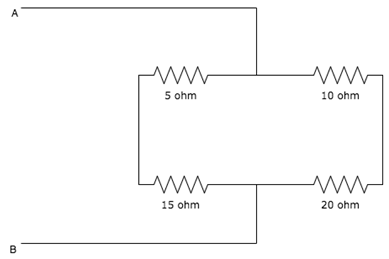
a) 60 ohm
b) 15 ohm
c) 12 ohm
d) 48 ohm
View Answer
Explanation: 5 ohm and 15 ohm are connected in series to give 20 ohm.10ohm and 20 ohm are connected in series to give 30 ohm. Now both equivalent resistances (20ohm and 30 ohm) are in parallel to give equivalent resistance 20*30/(20+30) = 12 ohm.
4. Calculate the resistance between A and B.
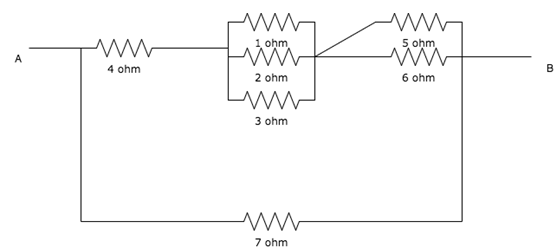
a) 3.56 ohm
b) 7 ohm
c) 14.26 ohm
d) 29.69 ohm
View Answer
Explanation: The 1 ohm, 2 ohm and 3 ohm resistors are connected in parallel. Its equivalent resistance is in series with the 4 ohm resistor and the parallel connection of the 5 ohm and 6 ohm resistor. The equivalent resistance of this combination is 80/11 ohm. This is in parallel with 7 ohm to give equivalent resistance between A and B is 3.56 ohm.
5. Batteries are generally connected in______
a) Series
b) Parallel
c) Either series or parallel
d) Neither series nor parallel
View Answer
Explanation: Batteries are generally connected in series so that we can obtain the desired voltage since voltages add up once they are connected in series.
6. In a _________ circuit, the total resistance is greater than the largest resistance in the circuit.
a) Series
b) Parallel
c) Either series or parallel
d) Neither series nor parallel
View Answer
Explanation: In series circuits, the total resistance is the sum of all the resistance in the circuit, hence the total is greater than the largest resistance.
7. In a ____________ circuit, the total resistance is smaller than the smallest resistance in the circuit.
a) Series
b) Parallel
c) Either series or parallel
d) Neither series nor parallel
View Answer
Explanation: in a parallel circuit, the equivalent resistance=1/sum of the reciprocals of all the resistances in the circuit. Hence it is smaller than the smallest resistance in the circuit.
8. Which is the most cost efficient connection?
a) Series
b) Parallel
c) Either series or parallel
d) Neither series nor parallel
View Answer
Explanation: The advantage of series-connections is that they share the supply voltage, hence cheap low voltage appliances may be used.
9. Calculate the equivalent resistance between A and B.
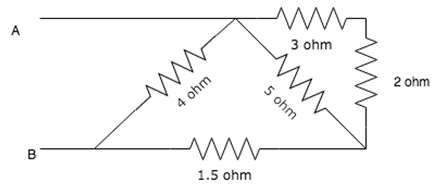
a) 2 ohm
b) 4 ohm
c) 6 ohm
d) 8 ohm
View Answer
Explanation: R=((2+3)||5)+1.5)||4. The 2 and the 3-ohm resistor are in series. The equivalent of these two resistors is 5 ohm and it is in parallel with the 5-ohm resistor. So, the net resistance will be 2.5 ohms. This equivalent 2.5-ohm resistor is in series with the 1.5-ohm resistor which will make it a 4-ohm equivalent resistor. Finally, this equivalent 4-ohm resistor is in parallel with the 4-ohm resistor which will make the final answer 2 ohms for the given circuit between points A and B.
10. Calculate the equivalent resistance between A and B.
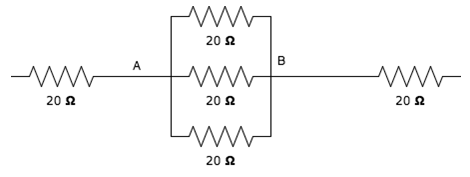
a) 6.67 ohm
b) 46.67 ohm
c) 26.67 ohm
d) 10.67 ohm
View Answer
Explanation: R=20||20||20=6.67 ohm. The three 20 ohm resistors are in parallel and re-sistance is measured across this terminal.
Sanfoundry Global Education & Learning Series – Basic Electrical Engineering.
To practice all areas of Basic Electrical Engineering, here is complete set of 1000+ Multiple Choice Questions and Answers.
If you find a mistake in question / option / answer, kindly take a screenshot and email to [email protected]
